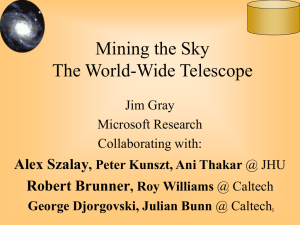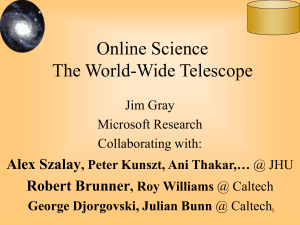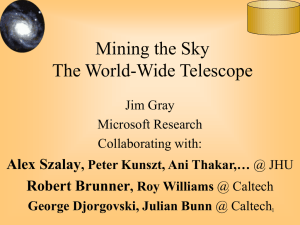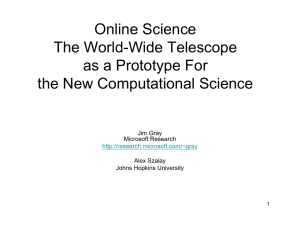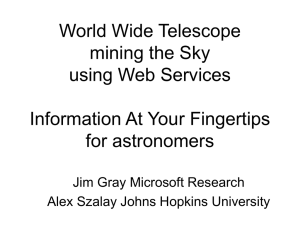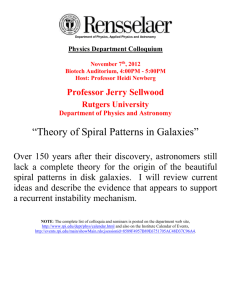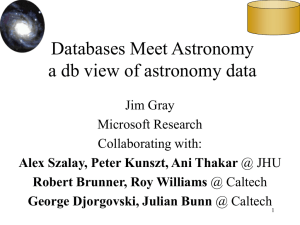Databases Meet Astronomy a db view of astronomy data Jim Gray Microsoft Research
advertisement
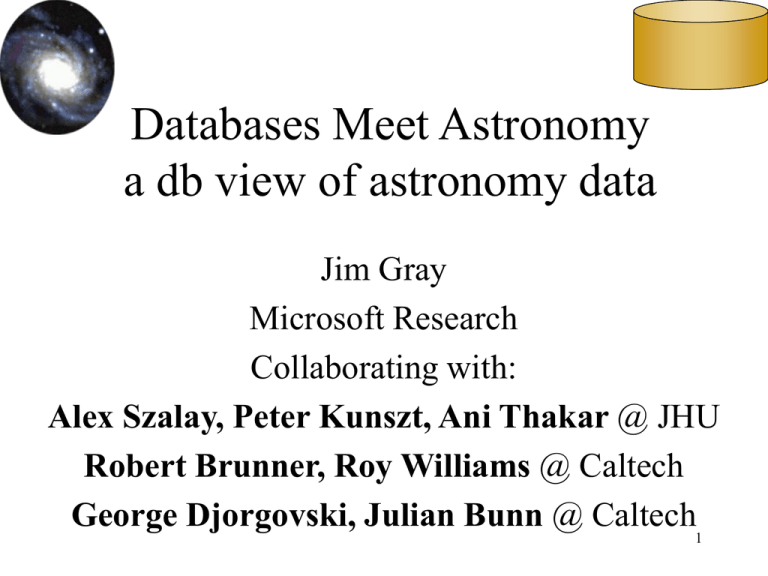
Databases Meet Astronomy a db view of astronomy data Jim Gray Microsoft Research Collaborating with: Alex Szalay, Peter Kunszt, Ani Thakar @ JHU Robert Brunner, Roy Williams @ Caltech George Djorgovski, Julian Bunn @ Caltech 1 Outline • Astronomy data • The Virtual Observatory Concept • The Sloan Digital Sky Survey 2 Computational Science • Traditional Empirical Science – Scientist gathers data by direct observation – Scientist analyzes data • Computational Science – Data captured by instruments Or data generated by simulator – Processed by software – Placed in a database – Scientist analyzes database 3 Astronomy Data Growth • • • • • In the “old days” astronomers took photos. Starting in the 1960’s they began to digitize. New instruments are digital (100s of GB/nite) Detectors are following Moore’s law. Data avalanche: double every 2 years 1000 100 Courtesy of Alex Szalay 10 1 0.1 1970 1975 1980 1985 1990 1995 2000 CCDs Glass Total area of 3m+ telescopes in the world in m2, total number of CCD pixels in megapixel, as a function of time. Growth over 25 years is a factor of 30 in glass, 30004 in pixels. Universal Access to Astronomy Data • Astronomers have a few Petabytes now. – 1 pixel (byte) / sq arc second ~ 4TB – Multi-spectral, temporal, … → 1PB • They mine it looking for new (kinds of) objects or more of interesting ones (quasars), density variations in 400-D space correlations in 400-D space • • • • • Data doubles every 2 years. Data is public after 2 years. So, 50% of the data is public. Some have private access to 5% more data. So: 50% vs 55% access for everyone 5 Astronomy Data Publishing and Access • But….. • How do I get at that 50% of the data? • Astronomers have culture of publishing. – FITS files and many tools. http://fits.gsfc.nasa.gov/fits_home.html – Encouraged by NASA. • But, data “details” are hard to document. Astronomers want to do it but it is VERY hard. (What programs where used? What were the processing steps? How were errors treated?…) • The answer is 42. 6 Astronomy Data Access • And by the way, few astronomers have a spare petabyte of storage in their pocket. • But that is getting better: - Public SDSS is 5% of total - Public SDSS is ~50GB + 500GB of images (5TB raw) - “data” fits on a 200$ disk, 2000$ computer. - (more on that later). - THESIS: Challenging problems are publishing data providing good query & visualization tools 7 Time and Spectral Dimensions The Multiwavelength Crab Nebulae Crab star 1053 AD X-ray, optical, infrared, and radio views of the nearby Crab Nebula, which is now in a state of chaotic expansion after a supernova explosion first sighted in 1054 A.D. by Chinese Astronomers. 9 Slide courtesy of Robert Brunner @ CalTech. Even in “optical” images are very different Optical Near-Infrared Galaxy Image Mosaics BJ RF IN J H K BJ RF IN J H K 11 Slide courtesy of Robert Brunner @ CalTech. Exploring Parameter Space Manual or Automatic Data Mining • There is LOTS of data – people cannot examine most of it. – Need computers to do analysis. • Manual or Automatic Exploration – Manual: person suggests hypothesis, computer checks hypothesis – Automatic: Computer suggests hypothesis person evaluates significance • Given an arbitrary parameter space: – – – – – – Data Clusters Points between Data Clusters Isolated Data Clusters Isolated Data Groups Holes in Data Clusters Isolated Points Nichol et al. 2001 Slide courtesy of and adapted from 12 Robert Brunner @ CalTech. Outline • Astronomy data • The Virtual Observatory Concept • The Sloan Digital Sky Survey 15 Virtual Observatory http://www.astro.caltech.edu/nvoconf/ http://www.voforum.org/ • Premise: Most data is (or could be online) • So, the Internet is the world’s best telescope: – – – – It has data on every part of the sky In every measured spectral band: optical, x-ray, radio.. As deep as the best instruments (2 years ago). It is up when you are up. The “seeing” is always great (no working at night, no clouds no moons no..). – It’s a smart telescope: 16 links objects and data to literature on them. The Age of Mega-Surveys • Large number of new surveys – multi-TB in size, 100 million objects or more – Data publication an integral part of the survey – Software bill a major cost in the survey • The next generation mega-surveys are different – – – – top-down design large sky coverage sound statistical plans well controlled/documented data processing • Each survey has a publication plan MACHO 2MASS DENIS SDSS PRIME DPOSS GSC-II COBE MAP NVSS FIRST GALEX ROSAT OGLE ... • Federating these archives Slide courtesy of Alex17Szalay, Virtual Observatory modified by Jim Virtual Observatory Challenges • Size : multi-Petabyte 40,000 square degrees is 2 Trillion pixels – One band (at 1 sq arcsec) 4 Terabytes – Multi-wavelength 10-100 Terabytes – Time dimension >> 10 Petabytes – Need auto parallelism tools • Unsolved MetaData problem – Hard to publish data & programs – How to federate Archives – Hard to find/understand data & programs • Current tools inadequate – new analysis & visualization tools – Data Federation is problematic • Transition to the new astronomy – Sociological issues 18 3-steps to Virtual Observatory • Get SDSS and Palomar online – Alex Szalay, Jan Vandenberg, Ani Thacker…. – Roy Williams, Robert Brunner, Julian Bunn • Do some local queries and crossID matches with CalTech and SDSS to expose – Schema, Units,… – Dataset problems – the typical use scenarios. • Implement Web Service that lets you get data from both CalTech and SDSS (WSDL/SOAP/…) 19 Demo of Sky Server Alex Szalay of Johns Hopkins built SkyServer (based on TerraServer design). http://skyserver.fnal.gov/ 21 Virtual Observatory and Education • In the beginning science was empirical. • Then theoretical branches evolved. • Now, we have a computational branches. – The computational branch has been simulation – It is becoming data analysis/visualization • The Virtual Observatory can be used to – Teach astronomy: make it interactive, demonstrate ideas and phenomena – Teach computational science skills 22 What Next? (after the data online, after the web servers) • How to federate the Archives to make a VO? • Send XML: a non-answer equivalent to “send Unicode” • “Bytes” is the wrong abstraction Publish Methods on Objects. • Define a set of Astronomy Objects and methods. – Based on UDDI, WSDL, SOAP. – Each archive is a web service • We have started this with TerraService – http://TerraService.net/ shows the idea. – Working with Caltech (Brunner, Williams, Djorgovski, Bunn) and JHU (Szalay et al) on this 23 SkyServer as a WebServer WSDL+SOAP just add details Archive ss = new VOService(SkyServer); Attributes A[] = ss.GetObjects(ra,dec,radius) … ?? What are the objects (attributes…)? ?? What are the methods (GetObjects()...)? ?? Is the query language SQL or Xquery or what? 24 Outline • Astronomy data • The Virtual Observatory Concept • The Sloan Digital Sky Survey 25 Sloan Digital Sky Survey http://www.sdss.org/ • For the last 12 years a group of astronomers has been building a telescope (with funding from Sloan Foundation, NSF, and a dozen universities). 90M$. • Last year was engineer, calibrate, commission They are making the calibration data public. – 5% of the survey, 600 sq degrees, 15 M objects 60GB. – This data includes most of the known high z quasars. – It has a lot of science left in it but… that is just the start. • Now the data is arriving: – 250GB/nite (20 nights per year). – 100 M stars, 100 M galaxies, 1 M spectra. • http://www.sdss.org/ and http://www.sdss.jhu.edu/ 26 SDSS what I have been doing • Work with Alex Szalay, Don Slutz, and others to define 20 canonical queries and 10 visualization tasks. • Don Slutz did a first cut of the queries, I’m continuing that work. • Working with Alex Szalay on building Sky Server and making data it public (send out 80GB SQL DBs) 27 Two kinds of SDSS data • 15M Photo Objects ~ 400 attributes 20K Spectra with ~10 lines/ spectrum 28 Spatial Data Access (Szalay, Kunszt, Brunner) http://www.sdss.jhu.edu/ look at the HTM link • Implemented Hierarchical Triangular Mesh (HTM) as table-valued function for spatial joins. • Every object has a 20-deep Mesh ID. • Given a spatial definition: Routine returns up to ~10 covering triangles. • Spatial query is then up to ~10 range queries. • Very fast: 10,000 triangles / second / cpu. 29 The 20 Queries Q1: Find all galaxies without unsaturated pixels within 1' of a given point of ra=75.327, dec=21.023 Q2: Find all galaxies with blue surface brightness between and 23 and 25 mag per square arcseconds, and -10<super galactic latitude (sgb) <10, and declination less than zero. Q3: Find all galaxies brighter than magnitude 22, where the local extinction is >0.75. Q4: Find galaxies with an isophotal surface brightness (SB) larger than 24 in the red band, with an ellipticity>0.5, and with the major axis of the ellipse having a declination of between 30” and 60”arc seconds. Q5: Find all galaxies with a deVaucouleours profile (r¼ falloff of intensity on disk) and the photometric colors consistent with an elliptical galaxy. The deVaucouleours profile Q6: Find galaxies that are blended with a star, output the deblended galaxy magnitudes. Q7: Provide a list of star-like objects that are 1% rare. Q8: Find all objects with unclassified spectra. Q9: Find quasars with a line width >2000 km/s and 2.5<redshift<2.7. Q10: Find galaxies with spectra that have an equivalent width in Ha >40Å (Ha is the main hydrogen spectral line.) Q11: Find all elliptical galaxies with spectra that have an anomalous emission line. Q12: Create a grided count of galaxies with u-g>1 and r<21.5 over 60<declination<70, and 200<right ascension<210, on a grid of 2’, and create a map of masks over the same grid. Q13: Create a count of galaxies for each of the HTM triangles which satisfy a certain color cut, like 0.7u-0.5g-0.2i<1.25 && r<21.75, output it in a form adequate for visualization. Q14: Find stars with multiple measurements and have magnitude variations >0.1. Scan for stars that have a secondary object (observed at a different time) and compare their magnitudes. Q15: Provide a list of moving objects consistent with an asteroid. Q16: Find all objects similar to the colors of a quasar at 5.5<redshift<6.5. Q17: Find binary stars where at least one of them has the colors of a white dwarf. Q18: Find all objects within 30 arcseconds of one another that have very similar colors: that is where the color ratios u-g, g-r, r-I are less than 0.05m. Q19: Find quasars with a broad absorption line in their spectra and at least one galaxy within 10 arcseconds. Return both the quasars and the galaxies. Q20: For each galaxy in the BCG data set (brightest color galaxy), in 160<right ascension<170, -25<declination<35 count of galaxies within 30"of it that have a photoz within 0.05 of that galaxy. Also some good queries at: http://www.sdss.jhu.edu/ScienceArchive/sxqt/sxQT/Example_Queries.html 30 An easy one Q15: Provide a list of moving objects consistent with an asteroid. • Sounds hard but there are 5 pictures of the object at 5 different times (colors) and so can compute velocity. • Image pipeline computes velocity. • Computing it from the 5 color x,y would also be fast • Finds 2167 objects in 7 minutes, 70MBps. select object_id, -- return object ID sqrt(power(rowv,2)+power(colv,2)) as velocity from sxPhotObj -- check each object. where (power(rowv,2) + power(colv, 2)) > 50 -- square of velocity and rowv >= 0 and colv >=0 -- negative values indicate error 32 Q15: Fast Moving Objects • Find near earth asteroids: SELECT r.objID as rId, g.objId as gId, r.run, r.camcol, r.field as field, g.field as gField, r.ra as ra_r, r.dec as dec_r, g.ra as ra_g, g.dec as dec_g, sqrt( power(r.cx -g.cx,2)+ power(r.cy-g.cy,2)+power(r.cz-g.cz,2) )*(10800/PI()) as distance FROM PhotoObj r, PhotoObj g WHERE r.run = g.run and r.camcol=g.camcol and abs(g.field-r.field)<2 -- the match criteria -- the red selection criteria and ((power(r.q_r,2) + power(r.u_r,2)) > 0.111111 ) and r.fiberMag_r between 6 and 22 and r.fiberMag_r < r.fiberMag_g and r.fiberMag_r < r.fiberMag_i and r.parentID=0 and r.fiberMag_r < r.fiberMag_u and r.fiberMag_r < r.fiberMag_z and r.isoA_r/r.isoB_r > 1.5 and r.isoA_r>2.0 -- the green selection criteria and ((power(g.q_g,2) + power(g.u_g,2)) > 0.111111 ) and g.fiberMag_g between 6 and 22 and g.fiberMag_g < g.fiberMag_r and g.fiberMag_g < g.fiberMag_i and g.fiberMag_g < g.fiberMag_u and g.fiberMag_g < g.fiberMag_z and g.parentID=0 and g.isoA_g/g.isoB_g > 1.5 and g.isoA_g > 2.0 -- the matchup of the pair and sqrt(power(r.cx -g.cx,2)+ power(r.cy-g.cy,2)+power(r.cz-g.cz,2))*(10800/PI())< 4.0 and abs(r.fiberMag_r-g.fiberMag_g)< 2.0 • Finds 3 objects in 11 minutes • Ugly, but consider the alternatives (c programs an files and…) – 33 34 39 40 Performance • Run times: on 3k$ PC (2 cpu, 4 disk, 256MB) • Some take 10 minutes • Some take 1 minute • Most take 15 seconds. • Ghz processors are fast! cpu vs IO 1E+7 IO count 1E+6 1E+5 100 IOs/cpu sec 1E+4 1E+3 ~100 IO/cpu sec ~5MB/cpu sec 1E+2 1E+1 1E+0 0.01 0.1 1. 100. 1,000. 10,000. CPU sec – (10 mips/IO, 200 ins/IO) 10000 10. cpu elapsed 1000 100 10 1 Q01 Q02: Q03 Q04 Q05: Q06 Q07 Q08 Q09 Q10 Q10A Q11 Q12*** Q13 Q14 Q15 Q16 Q17 Q18 Q19* 0.1 41 0.01 Q20 QSX01 Summary of Queries • 16 of the queries are simple • 2 are iterative, 2 are unknown • Many are sequential one-pass and two-pass over data • Covering indices make scans run fast • Table valued functions are wonderful but limitations on parameters are a pain. • Counting is VERY common. • Binning (grouping by some set of attributes) is common • Did not request cube, but that may be cultural. 42 Reflections on the 20 Queries • Data loading/scrubbing is labor intensive & tedious – AUTOMATE!!! • This is 5% of the data, and some queries take 1/2 hour. • But this is not tuned (disk bound). • All queries benefit from parallelism (both disk and cpu) (if you can state the query inside SQL). • Parallel database machines will do well on this: – Hash machines – Data pumps – See paper in word or pdf on my web site. • Conclusion: SQL looks good. Once you get the answers, you need visualization 43 Call to Action • If you do data visualization: we need you (and we know it). • If you do databases: here is some data you can practice on. • If you do distributed systems: here is a federation you can practice on. • If you do astronomy educational outreach here is a tool for you. • The astronomy folks are very good, and very smart, and a pleasure to work with, and the questions are cosmic, so … 44
